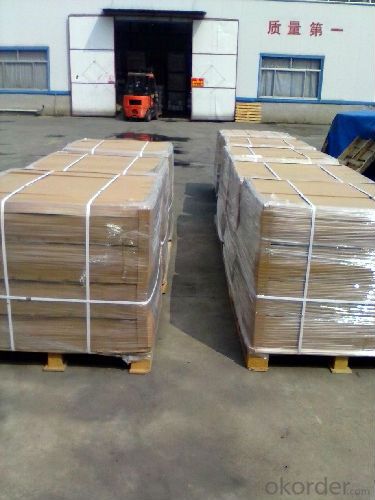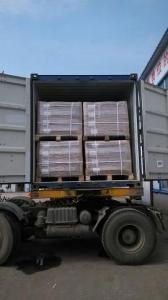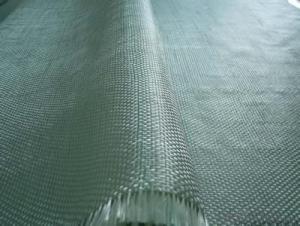C Glass Fiber Woven Fabrics
- Loading Port:
- China Main Port
- Payment Terms:
- TT or LC
- Min Order Qty:
- 17600 kg
- Supply Capability:
- 176000Kg Per Month kg/month
OKorder Service Pledge
OKorder Financial Service
You Might Also Like
1.Brief Introduction
C Glass fabrics are bidirectional fabric made by interweaving direct rovings.
C Glass fabrics are compatible with unsaturated polyester, vinyl ester, epoxy and phenolic resins.
C Glass fabrics are a high performance reinforcement widely used in hand lay up and robot processes to manufacture boats, vessels, plane and automotive parts, furniture and sports facilities.
2.Product Features
Warp and weft rovings aligned in a parallel and flat manner, resulting in uniform tension
Densely aligned fibers, resulting in high dimensional stability and making handling easy
Good moldability, fast and complete wet out in resins, resulting in high productivity
Good mechanical properties and high strength of parts
3.Product Specifications
Property | Area Weight | Moisture Content | Size Content | Width |
(%) | (%) | (%) | (mm) | |
Test Method | IS03374 | ISO3344 | ISO1887 | |
CWR200 | ±7.5 | ≤0.15 | 0.4-0.8 | 20-3000 |
CWR270 | ||||
CWR300 | ||||
CWR360 | ||||
CWR400 | ||||
CWR500 | ||||
CWR600 | ||||
CWR800 |
Special specification can be produce according to customer requirements.

4.FAQ
Packaging:
Each woven roving is wound onto a paper tube which has an inside diameter of 76mm and the mat roll has a diameter of 220mm. The woven roving roll is wrapped up with plastic film,and then packed in a cardboard box or wrapped up with kraft paper. The rolls can be horizontally placed. For transportation, the rolls can be loaded into a cantainer directly or on pallets.
Storage:
Unless otherwise specified,It should be stored in a dry, cool and rain-proof area. It is recommended that the room temperature and humidity should be always maintained at 15℃~35℃ and 35%~65% respectively.
- Q:Can fiberglass fabric be used in automotive applications?
- Yes, fiberglass fabric can be used in automotive applications. It is commonly used in various parts of the automotive industry, such as in the manufacturing of body panels, interior components, and insulation. Fiberglass fabric offers excellent strength-to-weight ratio, durability, and resistance to heat, making it suitable for automotive applications where lightweight and high-performance materials are required.
- Q:How does fiberglass fabric handle humidity?
- Fiberglass fabric is highly resistant to humidity. It does not absorb moisture, which prevents the growth of mold or mildew. This makes it an ideal material for applications in humid environments, as it retains its strength and durability even when exposed to high levels of moisture.
- Q:What are the different dyeing options available for fiberglass fabric?
- There are several dyeing options available for fiberglass fabric, each with its own advantages and considerations. 1. Pigment dyeing: Pigment dyeing involves adding pigments to the fabric, which bond with the fibers to create color. This method offers a wide range of color options and is relatively easy to use. However, it may not achieve deep or uniform color penetration, and the color may fade over time due to exposure to sunlight and other environmental factors. 2. Solution dyeing: In solution dyeing, the color is added to the liquid before it is turned into fibers. This results in a more permanent and fade-resistant color as the dye is integrated throughout the entire fabric. However, it limits the color options available as the dye must be added during the manufacturing process. 3. Disperse dyeing: Disperse dyeing is commonly used for synthetic fibers like fiberglass. It involves dispersing the dye in a carrier liquid and then applying it to the fabric through various methods such as immersion, padding, or spraying. Disperse dyeing offers good color fastness and can achieve vibrant and uniform colors. However, it requires high temperatures and pressure to ensure proper dye penetration. 4. Sublimation dyeing: Sublimation dyeing is a heat transfer process where the dye is converted from a solid to a gas and then back to a solid on the fabric. This allows the dye to bond directly with the fibers, resulting in vibrant and long-lasting colors. Sublimation dyeing offers excellent color fastness and the ability to achieve intricate patterns and designs. However, it requires specialized equipment and is typically more suitable for large-scale production. It is important to note that the dyeing options available may vary depending on the specific type and composition of the fiberglass fabric. Additionally, the choice of dyeing method should consider factors such as the desired color, durability, and application requirements.
- Q:Can fiberglass fabric be used for insulation in homes?
- Indeed, insulation in homes can be achieved through the utilization of fiberglass fabric. This particular fabric is frequently employed as an insulation material owing to its remarkable thermal characteristics. Its ability to adeptly capture and retain heat renders it a superior choice for the insulation of residential properties. Moreover, fiberglass fabric boasts attributes such as being lightweight, malleable, and effortless to install, rendering it a pragmatic alternative for various insulation purposes. Furthermore, the fabric's non-combustible nature and resistance to moisture contribute to its longevity and suitability for domestic applications. All in all, fiberglass fabric is a highly sought-after and dependable insulation material that finds widespread usage in numerous residential structures.
- Q:What is the tensile strength of fiberglass fabric?
- The tensile strength of fiberglass fabric varies depending on the specific type and weave of the fabric. However, on average, fiberglass fabric has a tensile strength ranging between 3000 to 5000 pounds per square inch (psi). This makes it a very strong and durable material, capable of withstanding high levels of tension and stress without breaking or tearing. Its excellent tensile strength makes fiberglass fabric a popular choice in various applications such as aerospace, automotive, construction, and marine industries.
- Q:How do fiberglass fabrics perform in terms of abrasion resistance?
- The outstanding property of fiberglass fabrics is their exceptional resistance to abrasion. This is because their composition consists of delicate glass fibers intricately woven together, resulting in a strong defense against wear and tear caused by rough surfaces. Consequently, fiberglass fabrics possess remarkable durability, making them an ideal choice for industries such as automotive and industrial sectors that necessitate protection against abrasion. Moreover, the smooth surface finish commonly found in fiberglass fabrics enhances their capacity to endure friction and uphold their integrity throughout time. In conclusion, fiberglass fabrics are renowned for their excellent performance in terms of resisting abrasion.
- Q:How is fiberglass fabric tested for quality assurance?
- Fiberglass fabric is tested for quality assurance through various methods including visual inspection, physical testing, and chemical analysis. Visual inspection involves examining the fabric for any defects such as holes, tears, or uneven weaving. Physical testing involves evaluating the fabric's strength, flexibility, and durability through tests like tensile strength, elongation, and abrasion resistance. Chemical analysis is conducted to ensure that the fabric meets specific standards and does not contain any harmful substances. These comprehensive tests help ensure that fiberglass fabric meets the required quality standards before it is used in various applications.
- Q:Is fiberglass fabric suitable for use in architectural membranes?
- Architectural membranes can indeed benefit from the use of fiberglass fabric. This material, known for its versatility and durability, offers numerous advantages in architectural applications. Lightweight yet strong, fiberglass fabric provides exceptional structural support for membrane structures. It also boasts resistance to UV radiation, chemicals, and weathering, ensuring long-lasting performance and durability. Furthermore, fiberglass fabric can easily be manipulated and shaped to suit different architectural designs, making it highly adaptable for roofs, canopies, and facades. Its translucency is another noteworthy feature, as it allows natural light to filter through, resulting in visually appealing and energy-efficient environments. Moreover, fiberglass fabric is fire-resistant, making it a safe option for architectural membranes. It also requires minimal maintenance, reducing the need for frequent repairs or replacements. In conclusion, fiberglass fabric is a suitable material for architectural membranes due to its strength, durability, versatility, and other beneficial properties. Architects and designers seeking innovative and reliable solutions for their projects can confidently choose fiberglass fabric.
- Q:What is the typical lifespan of fiberglass fabrics?
- The lifespan of fiberglass fabrics can vary depending on factors such as fabric quality, usage environment, and maintenance. Generally, fiberglass fabrics are known for being durable and long-lasting, and with proper care, they can last 10 to 30 years or more. Fiberglass fabrics find common use in insulation, construction, and the manufacturing of boats, automobiles, and aircraft. These industries subject the fabrics to harsh conditions, extreme temperatures, and chemical exposure. Despite these challenges, fiberglass fabrics can maintain their structural integrity and performance for a significant period. However, it is important to consider certain factors that can affect the lifespan of fiberglass fabrics. Over time, exposure to UV radiation can cause the fabric to degrade and weaken. Improper handling, excessive abrasion, and lack of maintenance can also shorten the lifespan. To maximize the lifespan of fiberglass fabrics, it is recommended to regularly inspect, clean, and maintain them. This involves keeping the fabric clean, avoiding excessive abrasion or impact, and promptly repairing any damages or tears. Additionally, applying protective coatings or treatments can provide extra protection against UV radiation and chemical exposure. In summary, fiberglass fabrics typically last 10 to 30 years or longer, depending on various factors. With proper care and maintenance, they can offer durability and performance for a significant period, making them a reliable choice for industrial and commercial applications.
- Q:Can fiberglass fabric be used for reinforcement in underground storage tanks?
- Yes, fiberglass fabric can be used for reinforcement in underground storage tanks. Its high strength, corrosion resistance, and durability make it a suitable material for reinforcing the structure of underground storage tanks, ensuring their structural integrity and preventing leaks or failures.
1. Manufacturer Overview |
|
|---|---|
| Location | |
| Year Established | |
| Annual Output Value | |
| Main Markets | |
| Company Certifications | |
2. Manufacturer Certificates |
|
|---|---|
| a) Certification Name | |
| Range | |
| Reference | |
| Validity Period | |
3. Manufacturer Capability |
|
|---|---|
| a)Trade Capacity | |
| Nearest Port | |
| Export Percentage | |
| No.of Employees in Trade Department | |
| Language Spoken: | |
| b)Factory Information | |
| Factory Size: | |
| No. of Production Lines | |
| Contract Manufacturing | |
| Product Price Range | |
Send your message to us
C Glass Fiber Woven Fabrics
- Loading Port:
- China Main Port
- Payment Terms:
- TT or LC
- Min Order Qty:
- 17600 kg
- Supply Capability:
- 176000Kg Per Month kg/month
OKorder Service Pledge
OKorder Financial Service
Similar products
New products
Hot products
Hot Searches
Related keywords




























